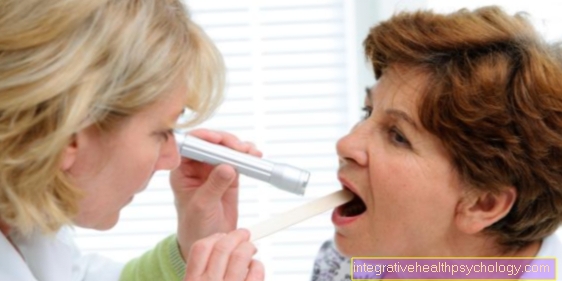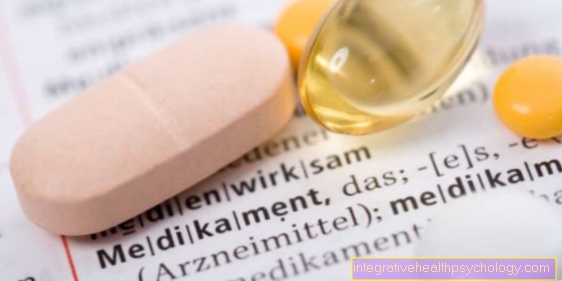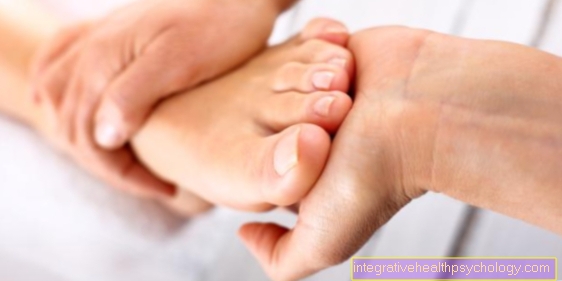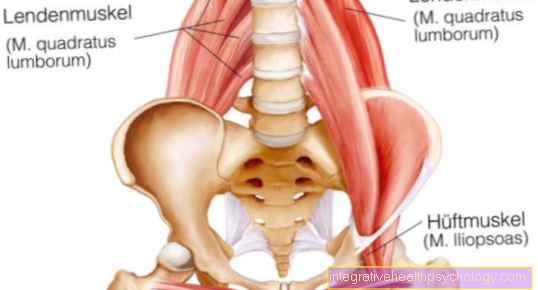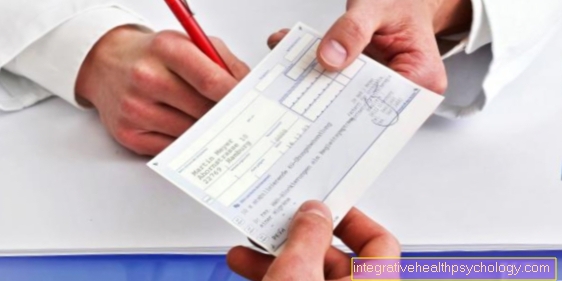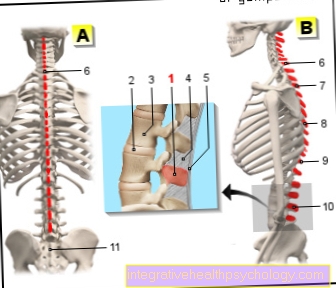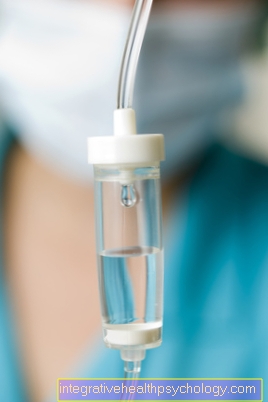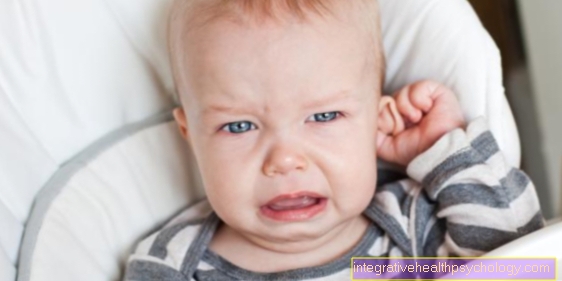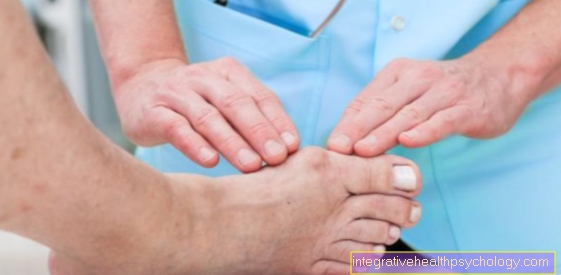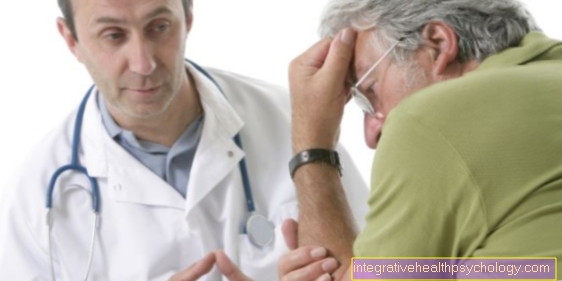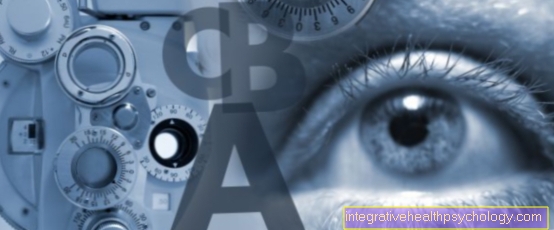Pregnancy depression
definition
Pregnancy is a stressful, exciting but also wonderful time for every woman. Unfortunately, this does not apply to all women. Almost every tenth pregnant woman develops pregnancy depression, where symptoms such as sadness, listlessness, feelings of guilt and listlessness are in the foreground. Such depression of pregnancy occurs particularly frequently in the first and third trimesters (Third of pregnancy) on.

The causes of such depression in pregnancy can be numerous. These range from unprocessed childhood trauma such as sexual abuse or the loss of close relatives, to a genetic predisposition for depression, to general stressful situations before and during pregnancy (e.g. Moves, weddings, deaths). Physical complaints or complications during pregnancy, so-called high-risk pregnancies, are particularly important in the development of pregnancy depression.
However, many non-risk pregnancies also often suffer from fears and worries about the future of the baby and their partnership. Many women worry about whether they will be a good mother or whether their own child will be healthy. Often these then become triggers for pregnancy depression.
To speak of a PPD (postpartum depression = depression after pregnancy), it has to be a long-lasting mood lability that lasts for many months after the birth of a child. The course of pregnancy depression corresponds to that of a "Major depression“According to DSM IV (Diagnostic and Statistical Manual of Mental Disorders) and differs only in the special feature of the time of occurrence, namely after the birth.
This is exactly what makes the PPD in its effects on the psyche much more serious than a "major depression" without childbirth. Because while society expects the new mother to be happy about her new happiness, the person affected feels the opposite and must not show this clearly.
The mother's feelings towards the child are determined by alienation and distance. The mother's feelings, which are not understood from the outside, are answered by her with self-reproach. This in turn intensifies the depressive phase.
In the differential diagnosis, pregnancy depression must be distinguished from the so-called "baby blues". The “baby blues”, also known as “crying days” after childbirth, last a maximum of one week and occur in 80% of women giving birth.
This mood swings can be explained by the rapid drop in hormones after birth. For the development of pregnancy depression, many other factors must also be present, so that one can speak of serious depression.
In addition, postpartum psychosis (psychosis after childbirth) is another psychiatric disorder after childbirth. It is an affective-manic disease that occurs very rarely (2 in 1,000 deliveries).
How do you recognize pregnancy depression?
Pregnancy depression is not always easy to spot at first glance. Often their symptoms (physical complaints how Back pain, fatigue and listlessness) as a consequence of pregnancy, i.e. as "normal“Rated. However, sadness, hopelessness and listlessness occur over a period of time several weeks pregnancy depression should be considered.
Should also Feelings of guilt, strong Circles of thought and permanent To care, Insufficiency experience, such as Suicidal thoughts a doctor should be consulted as soon as possible. Because consequences of pregnancy depression can Risksto carry with you for both the mother and the unborn child. Development delays and Premature births of the baby are typical consequences. Other studies have shown that birth-specific fears (typical of pregnancy depression) with a increased pain perception and an extended period of birth, as well as retrospectively postpartum depression (so-called. Postpartum depression) being able to lead.
Is there a pregnancy depression test?
There are no special tests that reveal pregnancy depression. However, because the symptoms of gestational depression are similar in many symptoms to those of non-pregnant people, self-testing for depression can be instructive. There are numerous such tests on the Internet, for example on the website of the German Depression Aid. Here 9 questions must be answered with one of 5 possible answer options. The evaluation then takes place. Such a test can provide information about the possible presence of (pregnancy) depression, but is no substitute for a visit to the doctor.
Also read: Test for depression
causes
In a study with healthy mothers, women with gestational depression showed no abnormalities with regard to socio-economic or hormonal nature. Therefore, a multifactorial view describes the genesis (development) of the PPD most accurately. That means many different causes come into play.
There are less specific causes than the sum total of factors that ultimately determine the development of pregnancy depression.
Genetically predisposed women whose first-degree relatives were mentally ill are at risk of developing PPD.
Women who had depression prenatally (before birth) are also at risk.
Mentally, the woman's cognitive (mental) attitude to the new challenge as a mother is in demand.
Pregnancy and childbirth are experienced by the mother as a profound "life event" that involves a lot of changes. The separation between mother and child must first be dealt with by the woman giving birth.
Please also read: Postpartum depression
Then there is a role change from woman to mother, from man to father. The woman thinks about whether she and her partner are up to the new demands that are made on responsible parents. In addition, the woman is concerned about the extent to which the child will change her relationship with her partner and her position in professional life. If the woman cannot cognitively find any positive answers to these questions, she experiences the phase after the birth as stress.
In psychosocial terms, a stable relationship with a partner and the support of the family and the environment are crucial. If these supports fall away, it will be difficult for the woman to develop a confident and caring attitude towards her newborn.
In terms of hormones, the drop in estrogen and progesterone is only the trigger for depression of pregnancy. In particular, the loss of estrogen, which is 200 times higher during pregnancy, brings about major changes in the central neurotransmitter system. For example, the serotonin balance is largely dependent on the amount of estrogen. If the estrogen level drops, the production of the happiness hormone serotonin will also be affected. Concentration and mood decrease.
Read more on this topic: The role of serotonin / neurotransmitters in depression
When does pregnancy depression start after giving birth?
As the name suggests, pregnancy depression occurs during pregnancy. On the other hand, depression that only occurs after the birth is referred to as postpartum depression. Pregnancy depression can occur throughout pregnancy. Postpartum depression, also known as postpartum depression, can occur within 2 years of giving birth. In about 70% of cases, however, the depressive symptoms begin as early as the first two weeks after delivery.
Concomitant symptoms
Typical symptoms of pregnancy depression can include:
- Somatic (physical)
- Sleep disorder
- Loss of appetite
- Gastrointestinal complaints
- Mentally
- Obsessive thoughts
- anxiety
- confusion
- Overwhelming
- Self-blame
Read more on the topic: Sleep disorders in pregnancy
What can be signs of pregnancy depression?
Numerous symptoms can indicate the presence of depression during pregnancy. Negative thoughts, low moods, consistently sad mood, lack of drive, concentration disorders, anxiety and sleep disorders can occur.
Signs of postpartum depression can be a lack of energy, a sad mood, disinterest and apathy, ambivalent feelings towards the child, a lack of cheerfulness and lack of drive.
Symptoms such as sexual dysfunction, poor concentration, irritability, dizziness and anxiety can also occur. Thoughts of suicide can also play a role. You can also include the newborn child (thoughts of extended suicide).
Therefore, there is an urgent need for treatment, the treating family doctor or gynecologist should be consulted as soon as possible.
Most depressing for the mother are the indifferent feelings towards her child. The lack of power over displeasure and listlessness have a frightening effect on the mother. Obsessive thoughts of harming themselves and the child are an additional burden for the mother. She reacts to being a bad mother with feelings of guilt and self-reproach, which deepens her sense of insufficiency / inability.
diagnosis
Depression is still a taboo subject. Especially when the PPD (pregnancy depression) is not in line with the societal idea of a happy, caring mother.
This is one reason why the diagnosis of PPD is difficult and usually comes too late. The mother avoids any attempt to communicate her feelings and fears to anyone. Because the step towards openness about the true, depressed state of mind goes hand in hand with feelings of shame and the stigmatization of being mentally ill.
The gynecologist can use the first check-up after 6 weeks at the latest to assess the patient's emotional situation with the aid of a screening process based on EPDS (Edinburgh Postnatal Depression Scale). The EPDS contains 10 questions that relate to the patient's condition. If the patient scores more than 9.5 points (threshold value) in the evaluation, there is a high probability of suffering from pregnancy depression.
The screening process is more meaningful (valid) the better the compliance (cooperation) between the patient and the doctor. This can best be achieved with patient-centered treatment.
What can you do?
If there are indications of pregnancy depression, it is advisable to consult a doctor in any case. This can clarify whether the symptoms are just a temporary mood swings or whether the symptoms are real pregnancy depression. For the differentiation and diagnosis, the doctor has various questionnaires (such as. the BDI) to disposal.
Therapy ultimately adapts to the severity of the depression.
If it is only a case of a slight depressive mood, then advice from a doctor or an advice center is usually sufficient (e.g. Pro Familia) out. Pregnant women learn more about their illness and how a good social environment can help.
In severe cases, psychotherapy would be advisable, which, depending on the severity, can be combined with medication, so-called antidepressants. There are a number of good, approved medications that can be used with consultation with a psychiatrist.
therapy
Clarification and psychoeducation (this means psychological training in how to deal with the illness) contribute enormously to alleviating feelings of guilt and shame in the mother. The knowledge that her lack of drive and her insensibility towards the child can be explained by the clinical picture of pregnancy depression calms the mother down. There is a willingness to seek a conversation with a psychotherapist. The affected patient can assign her condition to an illness that can also be treated and addressed openly.
A 100% diagnosis of a depressive illness cannot yet be made. However, as soon as there are signs of PPD, interaction between family, social workers and the midwife should be sought. All these links can make the effort to relieve the depressed woman from her new tasks as a mother for the time being.
The aim is to create a calm atmosphere around the woman so that she becomes aware of her new role as a mother during psychotherapeutic treatment and can accept it for herself. She is all the more likely to do this when she learns how to treat her baby differently. "Mother-child play therapy" and "baby massage" are one of many programs that put the mother-child relationship under a different light and thus strengthen it.
Attempting to separate the child from the mother should be avoided because it only increases feelings of guilt and alienation from the child.
So that the woman suffering from PPD does not get the impression of being stigmatized as mentally ill, she should not be admitted to psychiatry. A treatment option within a hospital is better.
light therapy
Light therapy is primarily used in patients suffering from seasonal depression. The seasonal depression occurs mainly in the dark autumn and winter months and is triggered, among other things, by the lack of daylight. Light therapy also shows some success in patients who suffer from non-seasonal depression. Light therapy can therefore be a good idea for attempting therapy, especially during pregnancy when drug treatment of depression is difficult due to the risk to the unborn child.
Read more about this under Light therapy for depression
Medical therapy

The effects of hormones such as estrogen on pregnancy depression are currently being investigated in terms of drugs. There was already some evidence that transdermal (through the skin) administration of 200 micrograms of estrogen daily improved mood in people with PPD. Further studies need to follow to confirm this assumption.
In most cases, major depression requires drug treatment with an antidepressant. However, these have been viewed with suspicion since the incident with Contergan (thalidomide, a sedative), which when taken during pregnancy caused deformities in babies.
Even after the birth, the use of psychotropic drugs / antidepressants has the disadvantage that the drug can be found in breast milk and thus gets into the baby's body when breastfeeding.
It is important that the doctor informs the patient concerned about the opportunities and risks of psychotropic drugs / antidepressants.
Today's psychotropic drugs (SSRIs) have far fewer side effects than classic benzodiazipins or tricyclic antidepressants. Infants tolerate the small amounts of serotonin reuptake inhibitors (SSRIs) well because the drug is below the detection limit in serum saliva or in breast milk.
Sertraline and paroxetine are among the well-known SSRIs. Sertraline is administered in a dosage range of 50-200mg, while 20-60mg is sufficient for paroxetine. The initial intake phase can be accompanied by side effects such as restlessness, tremors and headaches in the mother.
The patient should be aware that a small amount of the drug always finds its way into the child's circulation via breast milk. The smaller the baby, the worse it can metabolize the active ingredients in the drug. In addition, the active ingredient accumulates in the CNS (central nervous system) to a greater extent than in children, because the blood-liquor barrier in infants is not yet fully developed.
In summary, it can be said that the effectiveness of psychotherapeutic treatment is much more productive than that of drug therapy. In difficult cases where there is no guarantee for the safety of the mother and her child, psychotropic drugs / antidepressants cannot be dispensed with.
You can find more about drug treatment under our topic: antidepressant
Allowed drugs in case of depression of pregnancy
There are a number of very well-studied drugs that can be used for pregnancy depression that will not harm the child. Due to the extensive experience, the antidepressants of first choice in the case of pregnancy depression are amitriptyline, imipramine and nortriptyline from the group of tricyclic antidepressants; as well as sertraline and citalopram from the group of selective serotonin reuptake inhibitors (SSRI).
None of the classic antidepressants (SSRI, Tricyclic Antidepressants) have teratogenic (teratogenic) Effects are shown, which is why drug therapy can be carried out without problems in most cases.
However, other antidepressants such as opipramol can also be used, especially if these have proven to be particularly beneficial in patients with depression that is difficult to control. However, there are only a few studies on their effects on the newborn, so that their application must be viewed with caution.
In general, however, women who are already on an antidepressant should continue to take it until childbirth. Stopping or changing medication should be avoided if possible, as this could have devastating effects on both mother and child.
Only fluoxetine should be avoided due to its very long half-life and the associated poor control.
Amitriptyline
Amitriptyline belongs to the class of tricyclic antidepressants, making it one of the oldest and most effective psychotropic drugs that exist.
It is one of the drugs of first choice for pregnant and breastfeeding women.
Studies from the 1970s and 1980s showed an increased rate of heart and extremity (arm and leg) malformations; however, current studies could not prove these side effects.
If amitriptyline is taken until the child is born, this can lead to temporary withdrawal symptoms in the newborn with shortness of breath and increased tremors. To avoid any complications, the newborn should be admitted to a neonatology clinic for observation for a few weeks.
Because of its lack of effects on the child, amitriptyline is the best antidepressant for breastfeeding.
Citalopram and Sertraline (SSRI)
Citalopram and sertraline belong to the class of selective serotonin reuptake inhibitors and are two of the best studied drugs in relation to pregnancy. In addition to amitriptyline, they are the best alternative in drug therapy for pregnancy depression.
There are over 100,000 studies of the effects of citalopram and sertraline during and after pregnancy. In none could teratogenic (teratogenic) Side effects are noted.
If citalopram and sertraline are given until the end of pregnancy, temporary withdrawal symptoms (shortness of breath, increased tremors and hypoglycaemia (Hypoglycemia)) come in newborns. Again, the newborn should be observed in a neonatology clinic for a few weeks to prevent any complications.
Therapy with sertraline is preferable to therapy with citalopram during breastfeeding, as sertraline has no known side effects on the child. Citalopram can lead to poor drinking, restlessness and mental cloudiness in the newborn. In such cases, you should always see a pediatrician.
Pregnancy Depression and Homeopathy
Depression of pregnancy can also be treated by alternative methods. This also includes homeopathic therapeutic approaches.
Read more on the subject below Homeopathy and Pregnancy Depression
Duration
Pregnancy depression occurs more frequently in the first or last trimester of pregnancy and can last for several weeks. In the worst case scenario, pregnancy depression can turn into a postpartum depression, the so-called Postpartum depression pass over.
This postpartum depression is of the so-called Baby blues („Howling days"), Which usually occurs 3-5 days after birth and disappears by itself after a few days. This is normal and may be due to the sudden change in hormones arise. Keep symptoms like irritability, Mood swings, sadness and Feelings of guilt However, longer than 2 weeks, one speaks of postpartum depression or postpartum depression, which in the worst case can also be chronic.
How can you prevent pregnancy depression?

You cannot always prevent pregnancy depression, especially if you have a genetic predisposition to it. However, there are things that can be done to prevent the onset of pregnancy depression.
A stable social environment that supports and relieves the pregnant woman and where the pregnant woman can understand her fears and worries is particularly important. If pregnant women cannot find support from home, they can turn to numerous advice centers.
Work difficulties or stressful situations such as moving should also be avoided if possible. There are special laws for maternity leave in the workplace.
Find out more at: Maternity leave - you should know that!
After birth
Especially women who already have a depression suffered, have a higher risk to develop depression even after birth, a so-called Postpartum depression. This usually begins slowly several weeks after the birth and, like the well-known baby blues, is initially through Mood swings and increased irritability marked; later also through Lack of drive, listlessness, Attachment disorders to the child and Feelings of guilt.
In severe cases it can even be postpartum Psychosis (Postpartum psychoses) With Hallucinations and Delusions occur.
Postpartum depression often occurs Miscarriages, Stillbirths or when a sick or disabled child is born.
Here, too, it is important to contact a doctor or an advice center early on (Pro Familia) and not try to deal with the disease on your own. In mild cases, understanding and support from the partner, family and friends are sufficient. In severe cases are here too Medication, such as psychotherapy advisable.
Pregnancy depression in men
New studies show that around 10% of all fathers fall into depression of pregnancy after the birth of their first child. Men, whose wives also suffer from postpartum depression, are particularly at risk.
Pregnancy depression in men often only manifests itself indirectly through increased work or pursuit of hobbies. Only a few men show classic symptoms such as lack of drive, listlessness, sadness or brooding. Often it is only sleep disorders and tiredness thatnormal“Be dismissed.
An important reason for developing pregnancy depression in men is usually the transition to a new life with a baby. Many men suddenly feel excluded and less loved by their wife's close bond with the baby. This leads to partnership conflicts and frustration. Finally, if there are sleep deprivation and the pressure to feed the family, the fathers are usually overwhelmed, which ultimately leads to depression.
If there are symptoms of depression, it is advisable to consult a doctor or a counseling center. In severe cases, psychotherapy and medication help, but mostly it only takes time to come to terms with the suddenly changed life situation.
prophylaxis
The risk of recurrence from pregnancy depression is high, especially in women with a family history. Careful observation of these patients can help ensure that the PPD does not go unnoticed and develop to the detriment of the child. The mother-child relationship suffers considerably from the mother's indifference. The physical and emotional neglect of the baby in the first few months has massive consequences for the child's development.
In addition, willingness to provide information is required. Brochures and an open ear from the nursing staff or doctor can reduce the mother's reluctance to talk about her symptoms.



